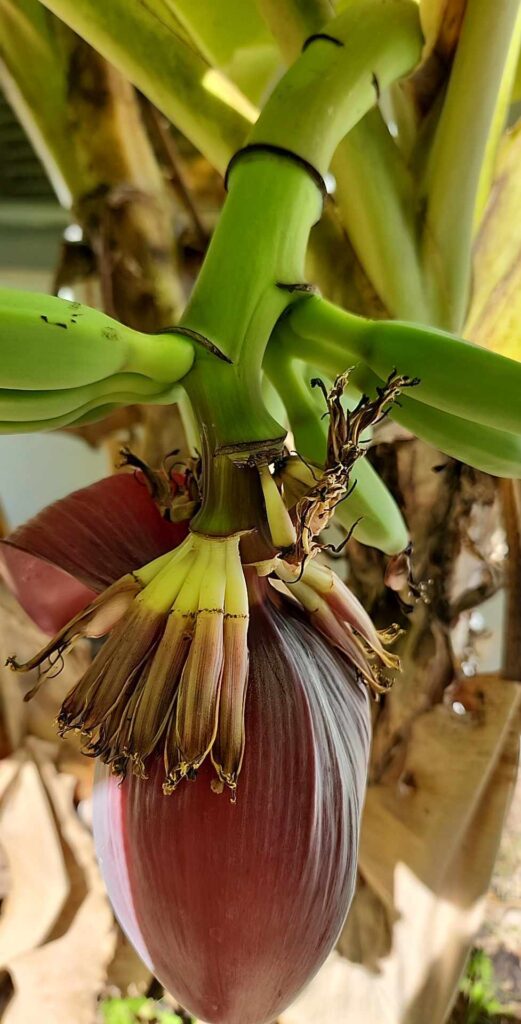Have you ever eagerly awaited the sweet, tropical fruit of your very own banana tree, only to be left wondering why it just won’t grow bananas? You’re not alone.
Many banana tree enthusiasts face this puzzling situation, and the solution might be simpler than you think. Imagine the joy of biting into a ripe banana, knowing it came from your own garden. This tantalizing possibility is within reach, but first, let’s unravel the mystery holding your tree back.
Whether it’s a matter of care, climate, or something else entirely, understanding the reasons behind your tree’s reluctance can transform your gardening experience. Stick around to discover the secrets that could lead to a fruitful future for your banana tree. Your tropical oasis is just a few insights away!

Credit: everglades.farm
Common Growth Issues
Banana trees may not produce fruit due to insufficient sunlight, poor soil, or incorrect watering. Nutrient deficiencies also hinder growth. Ensure the tree receives proper care and environmental conditions for optimal fruit production.
Growing a banana tree in your backyard can be a rewarding experience, but what happens when your tree isn’t producing bananas? Let’s explore some common growth issues that might be holding back your banana tree from bearing fruit. Understanding these factors can help you take the right steps to encourage healthy banana growth.Climate And Temperature
Banana trees thrive in warm, tropical climates. If you live in a region with cooler temperatures, your banana tree might struggle to produce fruit. Banana trees need consistent warmth, ideally above 60°F (15°C), to grow properly. Have you ever noticed how banana trees in tropical regions seem to flourish effortlessly? That’s because they enjoy the perfect climate. Consider using a greenhouse or moving your banana tree indoors during cooler months to maintain the warmth it needs.Soil Quality And Drainage
The soil your banana tree is planted in plays a crucial role in its growth. Bananas prefer rich, well-drained soil with plenty of organic matter. Poor soil quality can stunt growth and prevent fruit production. Imagine planting your banana tree in sandy or clay-heavy soil. It would struggle to get the nutrients and drainage it needs. Enhance your soil with compost or a good quality potting mix to improve its structure and fertility.Watering Practices
Watering your banana tree might seem straightforward, but it’s easy to get it wrong. Bananas need regular watering, but overwatering can lead to root rot and other problems. Think about your watering routine. Do you let the soil dry out before watering again, or do you keep it constantly wet? Aim for moist but not waterlogged soil. Adjust your watering schedule based on the season and weather conditions to keep your banana tree healthy and productive. By addressing these common growth issues, you can create an environment where your banana tree thrives. Have you checked your climate, soil, and watering practices lately? These might be the key factors preventing your banana tree from producing delicious bananas.
Credit: www.reddit.com
Nutrient Deficiencies
Banana trees not producing fruit can frustrate many gardeners. One common reason is nutrient deficiencies. Banana trees need a balance of essential nutrients. Without them, they struggle to grow and produce bananas. Let’s explore the crucial nutrients they need and how to spot deficiencies.
Essential Nutrients For Banana Trees
Banana trees need several key nutrients to thrive. Nitrogen is vital for leaf growth. Phosphorus supports root development. Potassium aids fruit production. Magnesium and calcium also play important roles. Each nutrient contributes to the tree’s health and fruiting ability.
Signs Of Nutrient Deficiencies
Look for signs if your banana tree lacks nutrients. Yellowing leaves indicate a nitrogen shortage. Poor root growth may signal a lack of phosphorus. Weak stems and small fruit often mean low potassium. Spotting these signs early can help you address the problem.
Pests And Diseases
Banana trees are a delightful addition to any garden. But sometimes, they might not produce those delicious bananas. Often, pests and diseases are the culprits. These pesky intruders can hinder growth and fruit production. Understanding these threats is crucial. It helps in ensuring your banana tree thrives.
Common Pests Affecting Banana Trees
Aphids are tiny pests that suck sap from leaves. They cause curling and yellowing. Spider mites are sneaky, causing leaves to look speckled and faded. Nematodes, invisible to the eye, attack roots. This leads to stunted growth. Banana weevils bore into the plant base. They weaken the tree structure. Regular checks are essential. They help catch these pests early.
Disease Symptoms To Watch For
Panama disease is a soil-borne fungus. It causes wilting and yellowing of leaves. Black Sigatoka is another fungal disease. It creates black streaks on leaves. Bacterial wilt leads to leaf browning and plant collapse. Leaf spot shows as small, dark patches on foliage. Monitor your tree closely. Early detection prevents spread.
Proper Plant Care
Proper plant care ensures banana trees bear fruit. Healthy growth needs attention and knowledge. Simple steps and the right techniques make a big difference. Understanding these methods helps your banana tree flourish.
Pruning Techniques
Pruning keeps your banana tree healthy and productive. Remove dead leaves and weak stems regularly. This promotes better air circulation and sunlight exposure. Always use clean, sharp tools to avoid damaging the tree. Focus on the oldest leaves first. This ensures new growth has enough space.
Mulching And Fertilization
Mulching helps retain soil moisture and control weeds. Use organic mulch like straw or wood chips around the base. This protects the roots and improves soil health. Fertilization is crucial for banana trees. Use a balanced fertilizer rich in potassium and nitrogen. Apply every few months for optimal growth. Follow the instructions on the fertilizer package carefully.
Environmental Factors
Growing bananas can be an exciting venture, but what happens when your banana tree just won’t produce those coveted fruits? Environmental factors might be the culprit. These factors can significantly influence your banana tree’s ability to bear fruit. Understanding how wind and sunlight play a role, along with knowing the ideal growing conditions, can help you solve this mystery.
Impact Of Wind And Sunlight
Wind can be both a friend and foe to your banana tree. While gentle breezes can aid in pollination, strong winds can damage the tree’s leaves and stalks, preventing it from producing bananas.
Consider planting your banana tree in a sheltered spot. You might find that the tree starts to thrive with just a bit of protection. Have you checked if your tree is getting enough sunlight? Banana trees need full sun, at least 6 hours a day.
Find a sunny location to ensure your tree gets the energy it needs for growth. Without enough sunlight, your tree might grow leaves but skip the fruit.
Ideal Growing Conditions
Banana trees thrive in warm, humid environments. They prefer temperatures between 75°F and 95°F. If your climate is cooler, consider creating a microclimate with greenhouses or windbreaks.
Humidity is also crucial. Banana trees love moisture, but not soggy soil. Ensure proper drainage and keep the soil consistently moist. Use mulch to retain moisture.
Are you watering your tree regularly? Inconsistent watering can stress the tree and affect its ability to produce fruit. Water deeply, but avoid overwatering.
Reflect on your tree’s location and care routine. Could these simple adjustments bring you closer to harvesting your own bananas?
Pollination Challenges
Growing a banana tree and not seeing bananas can be frustrating. One key reason could be pollination challenges. Bananas need proper pollination to produce fruit. Without it, even healthy trees might not bear bananas. Understanding the role of pollinators and ways to improve pollination can help.
Role Of Pollinators
Pollinators are crucial for banana trees. They help transfer pollen from one flower to another. This process helps the tree produce fruit. Common pollinators for bananas include bats and insects. Each plays a unique role in ensuring successful pollination. Without them, banana trees might struggle to grow bananas.
Improving Pollination Success
Improving pollination success starts with attracting pollinators. Planting flowers nearby can draw helpful insects and bats. Keeping the garden environment-friendly also supports pollinator health. Ensuring proper spacing between banana plants helps, too. This allows pollinators to reach each flower easily. Regularly checking for pests can prevent harm to pollinators. Healthy pollinators lead to better pollination success.
Selecting The Right Variety
Choosing the right banana variety is crucial for successful fruit production. Not all trees are suited to every climate. Ensure your banana tree is compatible with your region’s conditions to encourage healthy growth and fruiting.
Selecting the right banana variety is crucial for your tree’s success. Many gardeners struggle with banana growth. The variety chosen impacts banana production significantly. Some banana trees are ornamental and don’t produce edible fruit. Others thrive under specific climates. Understanding the variety is key. This section will guide you in choosing suitable varieties for your garden.Popular Banana Varieties
Banana plants come in many types. Cavendish is widely known for its sweet taste. It’s the common variety found in stores. Gros Michel was popular before diseases affected it. Dwarf Cavendish suits small gardens. It produces edible fruit and grows well. Red bananas offer a unique taste and color. They need warm climates to flourish. Lady Finger bananas are smaller but very sweet. These varieties vary in growth needs.Choosing Suitable Varieties
Consider your climate when selecting a variety. Some bananas need tropical conditions. Others can handle subtropical climates. Check your area’s temperature range. Soil type is also important. Ensure your soil drains well for healthy growth. Choose a variety that matches your garden size. Dwarf varieties are perfect for limited spaces. Research which bananas grow well in your region. This ensures your tree produces fruit successfully.
Credit: thesurvivalgardener.com
Frequently Asked Questions
Why Isn’t My Banana Tree Producing Fruit?
Banana trees need proper sunlight. At least 6 hours daily. Check for pests and diseases too.
How Do I Care For A Banana Tree?
Water regularly but avoid soggy soil. Use nutrient-rich fertilizer. Ensure sunlight exposure.
What Is The Best Climate For Banana Trees?
Warm and humid climates are ideal. They thrive in temperatures between 75°F and 95°F.
Are There Specific Banana Tree Varieties For Fruiting?
Yes, some varieties are better for fruit. Research and select the best type for your area.
How Long Does It Take For Bananas To Grow?
Typically, it takes 9 to 12 months. Climate and care affect growth duration.
Conclusion
Banana trees need proper care to produce fruit. Check sunlight and water levels. Fertilize regularly to ensure healthy growth. Watch for pests that may harm your tree. Consider the climate; bananas prefer warm weather. Prune your tree to remove dead leaves.
This helps it focus on fruit production. Soil quality also plays a role. Ensure it’s rich and well-draining. Patience is key; banana trees take time to mature. With attention and effort, your tree can thrive. Soon, it may reward you with delicious bananas.
Keep nurturing and observing for best results.




